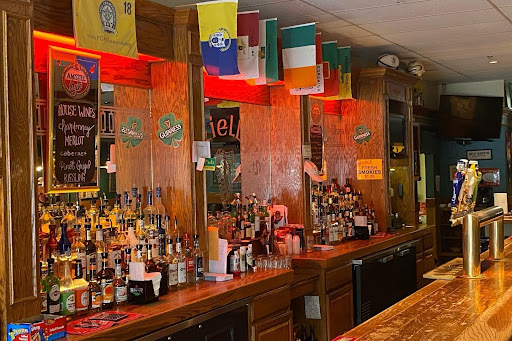Why there’s only one bar in University Heights

Patrick Kane investigates the history of University Heights’ hub known as O’Rielly’s Irish Bar.
May 12, 2023
Drinking culture, for better or for worse, is a mainstay of American college life. At the center of this culture is the traditional college bar, a watering hole dedicated to providing university students with a place to socialize and partake various assorted beverages.
A lot of college towns can have several such locations (even as many as 80, as is the case for Athens, Georgia, home of the University of Georgia). However, this is not the case for University Heights, Ohio, home of John Carroll University, housing only one bar within its limits.
Located in the Cedar Center, O’Rielly’s Irish Pub, opened by John O’Rielly in 1994 and purchased by Joe Vaughn Sr. in 1996, is University Height’s only true bar.
However, some contend with the assertion that because of this, there’s nowhere to drink in University Heights. UH Mayor Michael Dylan Brennan argues that bars are not the only places where one can buy alcohol.
“I think there are some bars in University Heights,” he asserted. “But what we have in University Heights is we have a lot of restaurants that have bars in them and they all have D5s. D5 is the big liquor license that has all the privileges of serving beer, wine and mixed drinks.”
According to Brennan, there are seven D5 liquor licenses in University Heights, each of which are owned by establishments like O’Rielly’s, Geraci’s Italian Restaurant, Applebee’s and even John Carroll University itself.
Nevertheless, “O’s” has become the go-to destination for both city residents and JCU students, something that its current owner, Joe Vaughn Jr., embraces.
“It’s a good niche to have,” Vaughn told The Carroll News. “We love the people of University Heights and the surrounding suburbs, we love the great university of John Carroll…we get a lot of business from them.”
Vaughn, who got his start bussing at the Winking Lizard and bartending in Miami, Ohio, has said that the culture at O’s has been compared to that of “Cheers,” the 1980s sitcom set at a bar in Boston. Vaughn also believes that the pub’s continued success is thanks to loyal local clientele, combined with good word of mouth. It is because of this, Vaughn argues, that the pub has received more business from John Carroll students within the past few years.
“Becoming the Carroll bar was pretty cool because, a lot of times, [the students] were going down to Coventry and Lee and everything.”
Vaughn said that, in order to accommodate this larger, younger customer demographic, O’s began to adjust their drink selection, including beverages like grenadine mixers, Blue Curacao and other elaborate and trendy drinks.
In spite of this adaptation and the distance, John Carroll students also seek out other options to drink and socialize. Many frequent downtown Cleveland establishments like Barley House and Dive Bar or attend the numerous house parties that pepper Warrensville Center Road.
Conor Ryan ‘22, a JCU senior, spoke of how he adjusts to University Heights’ lack of selection. “I usually drink either at my house or [my roommates and I] go downtown to have a couple drinks…We usually go to the Flats downtown. We’ll sometimes go to West 6th.”
Student behavior like this begs the question: why aren’t there many college bars in this college town? Some have posited that it may have to do with the city’s sizable Orthodox Jewish population. According to Noah Benjamin Bickart, head of John Carroll’s Department of Theology and an ordained rabbi, the inherent independence of Orthodox Judaism may play a part.
“Bar culture, I think, is seen as part of the American mainstream that in some ways Orthodox Judaism is trying to be countercultural against,” he said. This is supported by Vaughn, who has said that University Heights’s Orthodox population rarely, if ever, frequents O’Rielly’s. However, Bickart also pointed out that some Jewish practices, like the morning of Sabbath and the celebration of Passover, do include the consumption of alcohol and that kosher bars and restaurants do exist, just not in University Heights.
“[It isn’t that] Orthodox Jews don’t drink and therefore there aren’t any bars…but I definitely think there might be something in that much of what it means to be Orthodox is to some degree separatist.”
But the question still remains: why are there barely any bars within University Heights? Brennan argues that it has to do with the difference in culture in University Heights compared to other college towns.
“I went to Bowling Green as an undergrad, “ said Brennan. “You had the student bars and you had the ‘townie’ bars and you didn’t usually see one at the other. But here, we don’t really have those dividers. We have O’Rielly’s. Everybody goes to O’Rielly’s.”
This sentiment was parroted by Vaughn, who says that the local customer base and the student customer base mix well, implying that having a single bar is a status quo that, at this point, everyone has adapted to.
What is also a contributor, according to Brennan, is the simple fact that no one currently seems to want to open a new bar in University Heights. In the six years Brennan has been mayor, he says that he has never received an application to build or open one in spite of there being plenty of room.
“The city doesn’t do the developments, the city cooperates with people who want to bring in developments. So I’m not aware of anyone looking to bring in a new bar.”
If a new bar were to open in University Heights, Brennan says, he would welcome it. In contrast, Vaughn would not.That said, he does recognize the possibility.
“Obviously, competition breeds competition [and that means] more money and more capital,” he said.
As for the students, Ryan argues more bars should be a priority for both the city and the university, citing student safety as a concern.
“I think it would not only be more beneficial to the students but I think it would be more beneficial to the school as well. I think it would be much less of a liability because having kids go downtown in a place that might be unfamiliar to students is maybe a little bit dangerous, more dangerous than maybe going around bars that are here.”
Nevertheless, it seems that, at least for the foreseeable future, University Heights’ unique one-bar-fits-all ecosystem is here to stay.













Carrie Buchanan • May 29, 2023 at 11:32 pm
Patrick, I love this article. What a great idea to get the mayor to comment as well as the owner and patrons. Well done.
Keevin Berman • May 13, 2023 at 3:39 pm
When I went to JCU there was a bar on campus and a bar on Warrensville, I think called the Blue Streak. I never went there but on the south Euclid side of cedar